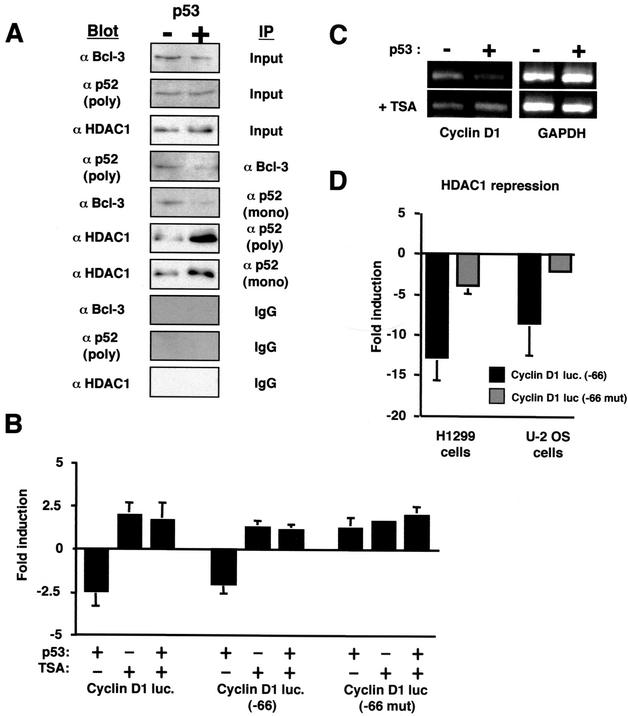FIG. 7.
Induction of p53 reduces p52/Bcl-3 complexes and increases p52 association with HDAC1. (A) Modulation of p52 complex formation by p53. Following 16 h of p53 induction by 100 μM IPTG in H1299w/tp53 cells, nuclear protein extracts were prepared. Immunoprecipitation experiments were then performed with either a monoclonal or polyclonal antibody to p52, Bcl-3 antibody, or an immunoglobulin G control, from 100 μg of protein extract. The immunoprecipitated complex was then resolved by SDS-PAGE and immunoblotted with the indicated antibodies. Samples of input material are shown (10 μg). (B) Inhibition of HDAC activity abolishes p53-mediated repression of the cyclin D1 promoter. One and a half micrograms of each of the cyclin D1, cyclin D1 (−66), and cyclin D1 (−66 mut) luciferase reporter plasmids was transfected into H1299w/tp53 cells. p53 was induced by treatment with 100 μM IPTG, and cells were harvested 16 h after induction. Cells were treated with 100 ng of TSA per ml for 16 h before harvesting as indicated. Results are expressed as change in activation or repression (n-fold) relative to levels seen in the relevant untreated cell controls. luc, luciferase. (C) Inhibition of HDAC activity abolishes p53-mediated repression of endogenous cyclin D1. RT-PCR analysis was performed by using primers specific to cyclin D1 or a GAPDH control, with total RNA (100 ng) prepared from H1299w/tp53 cells treated for 16 h with IPTG. Cells were treated with 100 ng of TSA per ml for 16 h before harvesting as indicated. (D) HDAC1 represses the cyclin D1 promoter in a κB element-dependent manner. The cyclin D1 (−66) or cyclin D1 (−66 mut) luciferase reporter plasmid (1.5 μg of each) was transfected into H1299w/tp53 or U-2 OS cells together with 1 μg of HDAC1 expression plasmid. Results are expressed as change in activation or repression (n-fold) relative to levels seen in the relevant untreated cell controls.

